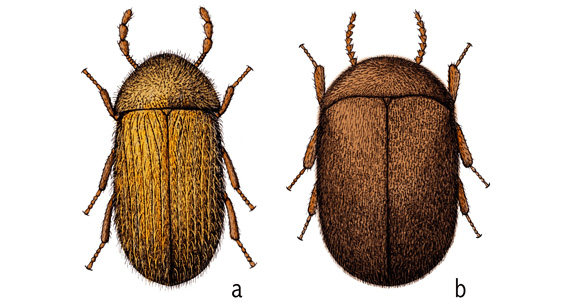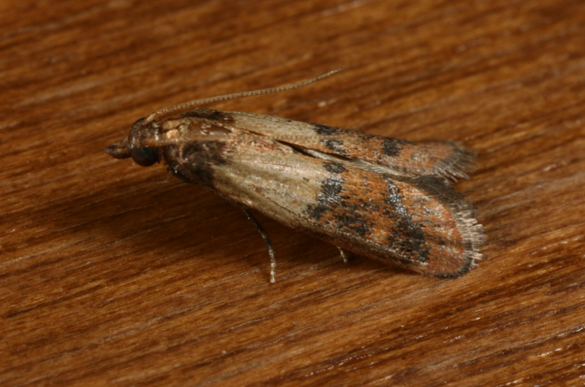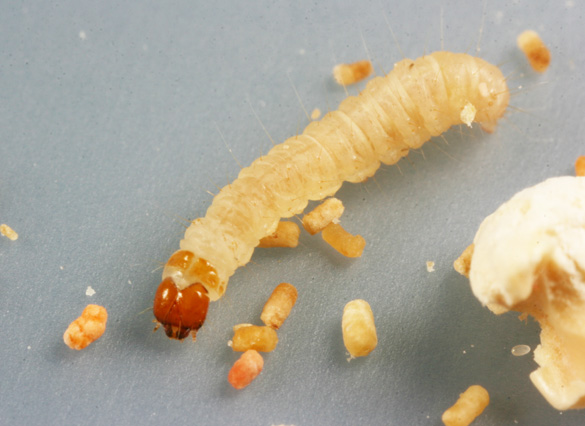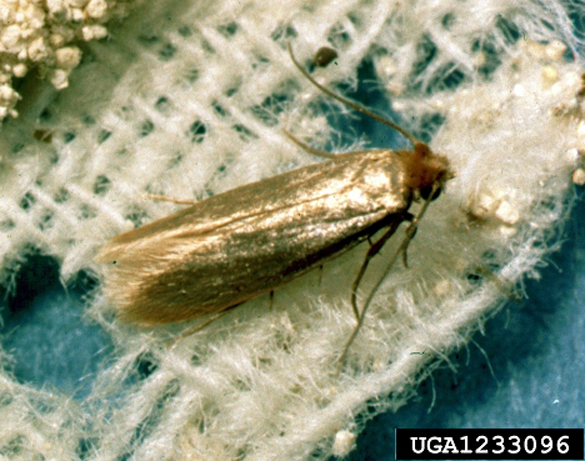Stored product pests are found in almost every home at some time. Yet few people recognize why stored product pests occur, or how to identify them. Many are transported into the home from a store or warehouse. Others originate in the home when susceptible items are stored for long periods of time.
Finding the same insect repeatedly in the home is a good indication of a stored product pest problem. Pantry pests are generally more common in kitchen or food storage areas, whereas fabric pests are found more frequently in closets or in rooms with a source of natural fiber, leather, or fur. Location can be deceiving, however. For example, some pantry pests infest carcasses of animals such as mice, rats or birds that may have died somewhere in the structure–not just in the pantry. Fabric pests may be found almost anywhere in a home.
Recognizing the pest will help you narrow down likely sources of the infestation. This handout is designed to help you identify some of the more common stored product pests.
Moths
Moths can be either pantry or fabric pests. However color patterns, size and behavior can generally help determine the food preference of the moth problem. Indian meal moth, Plodia interpunctella, is one of the most common indoor pests submitted to county Extension offices. This insect is readily identified by its two-toned (tan and copper colored) wing pattern. This insect feeds on dried fruits, nuts, chocolate, powdered milk, bird seed, dog food, and a variety of grain products. Full-grown larvae are pale and cream-colored and are usually about 13 mm long (range 9-19 mm). When fully developed, Indian meal moth larvae frequently wander in search of a place to pupate, and may be found on ceilings, walls and counter tops. Although adult Indian meal moths are primarily nocturnal, they are occasionally seen flying about during the day.
Control. Like other food-infesting moths, the Indian meal moth
must be controlled by first locating and eliminating infested food products. Insecticide sprays are not always needed. Often removing an old infested bag of flour is all that is needed. For heavier infestations, pesticides can be applied to corners and cracks around food storage areas. Pyrethrin-based foggers can provide temporary suppression of adult moths; but aerosols alone will not provide control until all infested foods are discarded. Pyrethrin, resmethrin, allethrin, and tetramethrin are common pesticides found in sprays designed for cockroach control. They are relatively safe to use in the kitchen, and can be used to treat cracks and crevices in food storage closets. If you have a pest control company that regularly services your home, ask about pheromone traps that are designed to monitor and help reduce pantry moth pests.
Clothes moths
Clothes moths, Tinea and Tineola species, can be distinguished from Indian meal moths and other food-infesting moths by their small size, wing shape and secretive nature. Adult clothes moths have a wingspan of about 1/2-inch and a body covered with shiny golden scales. Under a hand lens, the head can be seen covered with a fluffy pompadour of reddish-golden hairs. Adult clothes moths are not commonly seen because they tend to avoid light and are active primarily at night. Clothes moth larvae feed primarily on protein-based fibers such as woolen cloths and carpets, furs, pet hair, piano felts and natural hair brushes.
Control. Dry cleaning kills all stages of clothes moths, but will not prevent reinfestation. For this reason, recently dry-cleaned items should be placed in cold-storage (furs), or sealed in air-tight containers protected with fresh cedar chips or other fumigants. In general, cedar wood does not provide effective protection from clothes moths unless the wood is freshly cut or chipped and the container well-sealed. Aromatic oils found in cedar heartwood do kill clothes moth larvae if present in sufficient concentration; however few cedar chests more than two or three years old produce sufficient vapors to kill pests. Naphthalene and paradichlorobenzene (PBD) products are more effective, but must be sealed tightly with the clothes. Use 1-2 pounds of repellent per 100 cubic feet of air to kill moth larvae. Care must be taken with PDB crystals around certain plastic products, as many types of plastics will soften or melt in the presence of PDB fumes.
Infested articles may be sealed and placed in chest-type freezers (-4° F or -20° C) for at least 7 days to kill eggs and larvae. It is best to place infested articles in polyethylene bags prior to freezing to reduce the risk of damage due to rapid changes in moisture content. Heat can also be used to dis-infest clothing articles. Clothes moths are killed by exposure to 122° F (50° C) for 11-14 minutes, or 140° F (60° C) for as little as one minute. Beware of possible heat damage to some woolen articles at these temperatures. Regular (once or twice a month) airing and beating of woolen rugs and clothing also is a very effective method of control. Beating and brushing crushes eggs and larvae of clothes moths, and exposure to the hot sun causes larvae to become irritated and drop from the fabric.
Beetles
Numerous kinds of beetles can be found feeding on stored food and pantry items. They include weevils, cigarette and drugstore beetles, saw-toothed grain beetles, larder beetles, mealworms, and various flour beetles. These beetles feed on a wide variety of stored grains, fruits, spices, powdered milks, dried meats, or dead insects, birds, or mammals.

Drugstore, cigarette, and red flour beetles are among the most common home stored product pests. Adapted from USDA Pub. AH655.
Some very small scavenger beetles, known as minute fungus beetles and foreign grain beetles, are periodically found in large numbers. This occurs most often in new homes, where they appear to feed on fungi and mildew growing on wood and plaster drywall.
Control. Controls for beetles are similar to those for pantry-infesting moths. First locate the infestation source (or sources) then seal all un-infested foods in air-tight containers such as screw-top glass, heavy plastic or metal containers.
Knowing the specific kind of pest sometimes can help you pinpoint the most likely source; however, locating beetle infestations is often difficult. Inspect all cracks and crevices where food debris may accumulate, check food containers (many times even sealed containers may be infested inside and be loose enough to allow insects to escape), check under and around cabinet voids and appliances for spillage of grains, pet foods or other food products, vacuum and clean cabinets and doors in infested areas thoroughly. Rodent nests are sometimes the source of a persistent beetle infestation. Mice often hoard seeds and other stored products, which later become infested. Until you locate the source of the problem, the infestation will likely continue until the food source is consumed. If you have a pest control company that regularly services your home, ask about pheromone traps that are designed to monitor and help reduce pantry beetle pests.
After the source of infestation is eliminated, seal all food products that might become infested in tight containers. Ordinary metal kitchen canisters are not tight enough to exclude some insects. Tupperware containers, if air-tight, may work.
With heavy or widespread infestations, you may need to apply an insecticide spray to empty cupboards, drawers, and pantries. All food products, utensils and containers should be removed from the treatment area before spraying. Sprays must be allowed to dry before placing clean shelf paper on the shelves and returning food items.
Prevention. Pantry pest problems can usually be avoided by using all dried food within 2-4 months of purchase. Spices and other products that are to be kept for longer periods should be sealed in airtight containers. When you buy packaged foods, check that the bags or containers are well sealed. Keep food storage areas clean and clear of crumbs or food particles. Pet food is a major source of stored product pests. Be sure to store pet foods in well-sealed buckets or storage containers.
Carpet beetles
Carpet beetles are the most important beetle pests of fabric. Adult carpet beetles are small and round, approximately 1/16 to 1/8 inch-long. The wing covers are either black or mottled, with various patterns of black, gray, yellow and red scales. The larvae are carrot-shaped and are usually covered with numerous tiny, backward-pointing hairs. They feed on any source of animal protein including milk or cheese products, dead mice or birds, dead insects, fabrics and carpet made of natural fibers, dried meat, stuffed trophies, etc. In rare cases the small hairs on the bodies of carpet beetle larvae are known to cause irritation when swallowed (in infested food) or even pressed against the skin.
Control. Many of the same methods used to prevent and control damage caused by clothes moths can be applied to carpet beetles. In addition to inspecting furs, woolens, feathers, silks, wool carpets and other such materials, look for infestations in accumulations of dust and pet hair along baseboards, old bird or rodent nests in attics, and wherever dead insects accumulate, such as window sills and light fixtures.
Sanitation is the key to preventing carpet beetle problems. Woolen rugs, windowsills and light fixtures should be vacuumed frequently. Woolen garments should be inspected and periodically washed or dry cleaned. Pesticide treatment of woolen carpets (or natural hair pads sometimes used as cushioning under carpeting), furniture with hair stuffing, and other infested sites, may be needed in severe cases. Aerosol foggers do not work well unless all infested materials are first located and destroyed or treated.
Infested fabric articles may be treated with heat or cold, as described for clothes moths.
For more information
For more information about cigarette and drugstore beetles, see AgriLife Extension publication, E-486, Pantry and fabric pests in the home.
Author:
Michael Merchant, Ph.D., Professor and Extension Urban Entomologist, Texas AgriLife Extension Service. Images by the author unless otherwise indicated.



